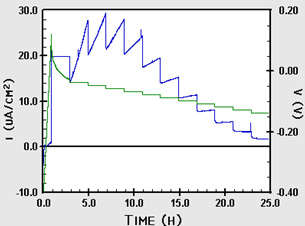THE Repassivation Potential Experimental Sequence
Like the Critical Pitting Potential experiment (ASTM F746), THE Method involves a Stimulation phase and a Repassivation phase.
The THE Repassivation Potential standard technique is run by selecting Experiment > DC Corrosion > THE Repassivation Potential from the Framework menu bar. This initiates the following sequence of events:
The Stimulation phase begins with a potentiodynamic ramp towards more anodic potentials. The ramp stops when the current reaches a critical threshold (20 μA/cm2), indicating that crevice corrosion has been initiated.
The Stimulation phase continues with the sample then galvanostatically held at this current density for a fixed time (2 hours). At the end of this galvanostatic hold, the potential is measured.
The test then enters the Repassivation phase. The cell is returned to potentiostatic control at the last potential measured in the Stimulation phase. The potential is then stepped towards the original open-circuit potential in 10 mV increments. During these potentiostatic steps a current-versus-time curve is measured. If the current continues to increase, that is an indication that crevice corrosion is continuing. If the current does not increase when the potential is held for two hours, then the Repassivation potential has been reached.

Sample potentiodynamic scan for THE Method. Potential is green, and current is blue.
The plot above shows the potential (green) and current (blue) recorded during a typical run. In this plot, the potentiodynamic scan lasted for about 1 hour and was terminated when the current density reached 20 μA/cm2. During the galvanostatic hold (hours 1 to 3) at this current density, the potential decays. At the end of the hold, the potential is stepped towards a more cathodic potential. We see that the current continues to increase during these steps. This is a clear indication that the crevice corrosion is still accelerating. Finally, when the potential is stepped to about –0.13 V, the current no longer increases, indicating that the repassivation potential has been reached.

Comments are closed.